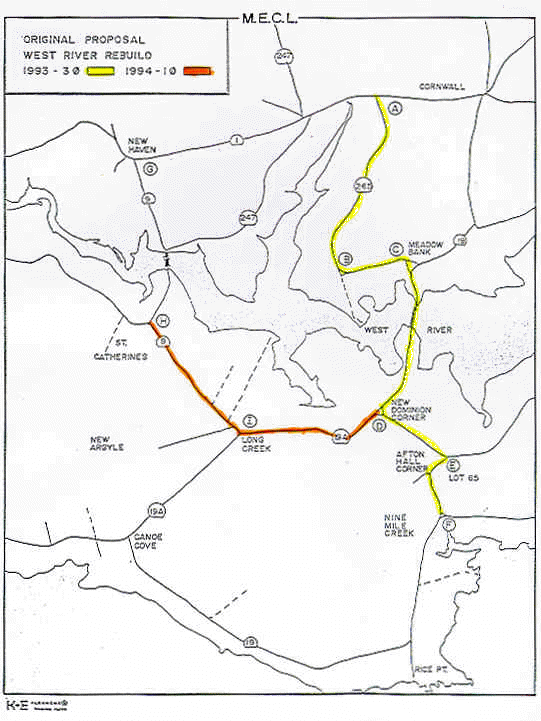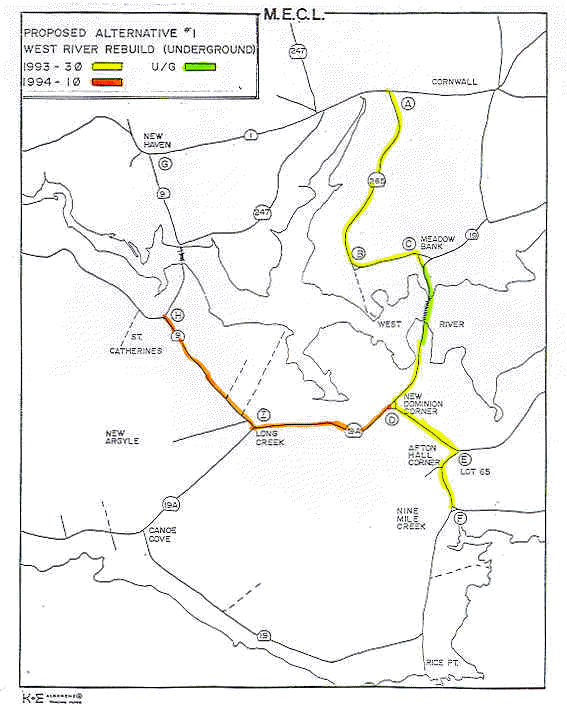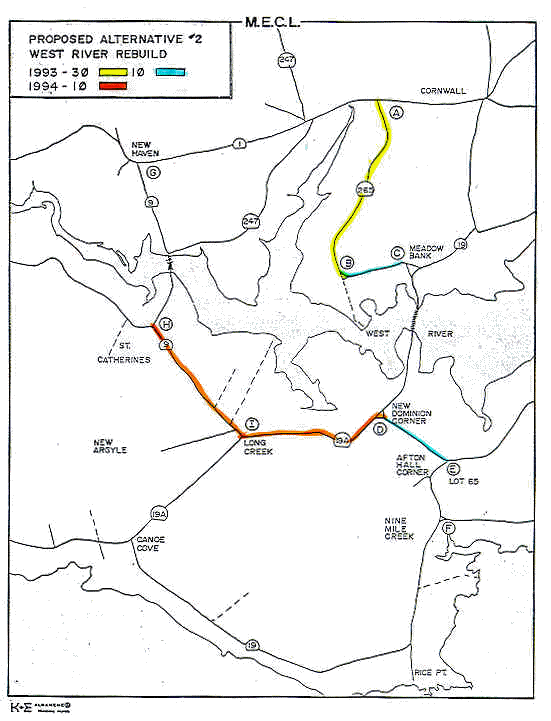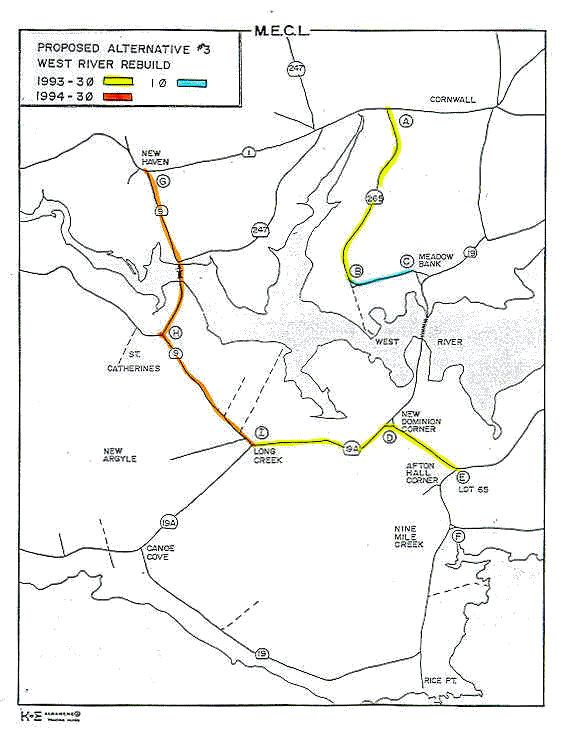Docket UE20403
Order UE93-14IN THE MATTER of a revised application by Maritime Electric Company, Line for approval of electrical service upgrading in the West River Area.
BEFORE THE COMMISSION
on Wednesday, the 14th day of July, 1993.
Linda Webber, Chair
John L. Blakney, Vice-Chair
Michael Ryan, Commissioner
Reasons for Order
1 Introduction & Background
In March of 1993, Maritime Electric Company, Limited (the "Company") applied to the Island Regulatory and Appeals Commission for approval to construct a three-phase power line across the West River Causeway. The application was subsequently approved by the Commission and the Department of Transportation and Public Works and work on the line commenced shortly thereafter.
When residents of the area became aware of the project through the appearance of power poles placed along the roadside of the proposed route, concern was expressed to the Commission over the visual impact the line would have on the area. As a result of these concerns, the Commission asked the Company to put the project on hold pending a review of servicing options for the area. Work on the line was subsequently halted and the Company commenced a review of alternative servicing options for the area.
Overall, the Commission received some twenty-one letters from area residents and an equal number of telephone calls commenting on the proposed line. While a number of residents expressed concern over the proposed routing of the line, many residents and organizations supported the proposed line. While the reasons for opposing the location of the line were similar—the line would have a negative visual impact on the area—the reasons for supporting the location of the line were varied. Many felt that the line would provide needed service improvements in the south shore area while others believed that the line would result in road lighting on the West River Causeway.
On June 18, 1993 the Company filed with the Commission a revised servicing proposal for the area. In view of the interest that area residents had shown in the project, the Commission decided to hold a public meeting to consider the revised proposal of the Company and to receive further input from area residents. The notice of this meeting together with a copy of the Company's revised servicing plan for the area were forwarded to residents who had contacted the Commission. The notice was also published in the local press.
The public meeting was subsequently held at 7:00 P.M. on July 7, 1993 at the Afton Community Center.
2 Servicing Options
The original proposal of the Company is shown in Appendix A. Essentially, the proposal would, if approved, see an overhead three-phase power line constructed over the West River Causeway, with associated line work carried out in the in the Meadow Bank, New Dominion, Long Creek and Afton areas.
The first alternative option considered by the Company—shown in Appendix B—would see a portion of the line work located in the area of the causeway placed underground. The balance of the work would be similar to the original proposal of the Company. A second alternative—shown in Appendix C—would see a three-phase line built along a portion of Route 265, with single-phase lines upgraded in the Meadow Bank, New Dominion, Long Creek and Afton areas. Under this option, three-phase service would not be extended to the south side of the West River. A third alternative—shown in Appendix D—would see a three-phase joint-use line constructed along Routes 9 and 19A, with the balance of the work in adjacent areas modified from the original proposal to satisfy electrical feed requirements in the area. This option is the preferred option of the Company and the one now submitted to the Commission for approval.
During the public meeting, the Company's Director of Customer Service, James Landrigan, outlined the Company's reasons for advancing alternative 3. According to Mr. Landrigan, alternative 3 would satisfy both the service needs of the area and the concerns that had been expressed over the visual impact of the original proposal. Moreover, Mr. Landrigan noted that the cost of alternative 3 was similar to the original proposal and would provide for joint-use service with Island Tel.
According to Mr. Landrigan, alternative 2 was rejected because it did not provide three-phase service to the area. Alternative 1 was rejected for two reasons: the cost of placing a three-phase line underground on the causeway was prohibitive ($460,000 compared to $284,000 for the original proposal and $290,000 for alternative 3) and would give rise to security of supply and safety concerns in the event that the underground line was inadvertently dug up or broken.
3 Discussion
While a number of residents who attended the meeting expressed support for the Company's revised servicing plan, several residents continued to support the original proposal. Comments were made to the effect that the original proposal would provide superior service to the area and would allow for the placing of street lighting on the causeway—something that several area residents indicated was needed.
Representatives of the Company indicated that the proposed alternative would provide an equal level of improved service to the area. John Gaudet, a senior electrical engineer with the Company, indicated that, with the Company's intention to service the distribution lines in the area off individual phases of the three-phase line, outages would be considerably reduced. The Company assured the Commision that the service level under the proposed alternative would not be inferior to the original plan.
The issue of street lighting on the causeway was the subject of some debate. During the meeting it was noted that the provision of street lighting on the causeway required an application from a "customer" who was prepared to pay for the service. Mr. Landrigan noted that he checked with the Department of Transportation and Public Works—the party that is normally the customer for street lighting in rural areas—and was "unofficially" advised that the Department had no immediate intentions of lighting the causeway. Notwithstanding this, certain residents seemed to believe that the mere existence of power poles on the causeway would aid in their efforts to secure causeway lighting.
It was noted by Company representatives that, even with the existence of a three-phase pole line across the causeway, the provision of street lighting would require considerably more than the attachment of light fixtures to the three-phase poles. In order to provide an adequate level of lighting, additional poles or light standards would be required as well as a secondary feed off the high voltage line. According to the Company, if a customer later applied for street lighting, the service could be provided via a low-voltage underground line. Since the low-voltage underground line would not be providing transmission service to the south-shore area, the Company would not have the same concerns it had expressed about underground three-phase service regarding service disruptions if the line was dug up or broken.
4 Decision
The Commission's principal criterion in evaluating any proposal of the Company is whether the proposal will provide safe and adequate service at the lowest possible cost. In situations where line work may or will have a significant negative visual impact on an area, the Commission is prepared to consider—as it has in this case—additional expenditures associated with mitigating this impact.
Based on the comments received and presentations made at the public meeting, the Commission is satisfied that the preferred alternative of the Company will meet the service-improvement needs of the area residents and will satisfy concerns over the visual impact of the original proposal. The Commission will monitor the service levels in the area to ensure that area residents are well served.
The street lighting issue is something the Commission cannot, in this decision, address. While we acknowledge the desire of certain residents and organizations to have street lighting on the causeway, we are not prepared to order the placement of either an overhead or underground high voltage line on the causeway on speculation that it might prompt the Provincial Government to proceed with lighting. In view of the Company's comments on the additional work that would be required to install lighting notwithstanding the existence of power on the causeway, such an order would serve no useful purpose.
In the result,
1. The revised application of the Company is hereby approved.
The Commission wishes to acknowledge and thank those who wrote, called and attended the public meeting. We also acknowledge the Company's efforts in coming up with what we consider a reasonable servicing alternative for the area. On completion of the work, area residents can expect a marked improvement in their electrical service.
An order will therefore issue.
IN THE MATTER of a revised application by Maritime Electric Company, Line for approval of electrical service upgrading in the West River Area.
Order
UPON the revised application of Maritime Electric Company, Limited (the "Company") for approval of electrical service upgrading in the West River area;
AND UPON hearing and considering presentations made by the Company and area residents and organizations;
IT IS ORDERED THAT
1. The revised application of the Company is hereby approved.
DATED at Charlottetown, Prince Edward Island, this 14th day of July, 1993.
BY THE COMMISSION:
Linda Webber, Chair
John L. Blakney, Vice-Chair
Michael Ryan, Commissioner
Appendix A
Appendix B
Appendix C
Appendix D




